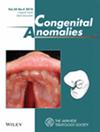胎儿MRI显示卡罗里综合征伴常染色体隐性多囊肾病1例
IF 1.3
4区 医学
Q3 PEDIATRICS
引用次数: 0
摘要
本文章由计算机程序翻译,如有差异,请以英文原文为准。
Caroli's syndrome with autosomal recessive polycystic kidney disease on fetal MRI: A case report
A 21-year-old pregnant woman (gravida 1, abortion 0) with a his-tory of acrocyanosis and raised AST/ALT was referred for ultrasound assessment. The gestational age was 32 weeks according to LMP and 31 weeks 2 days as per biometry. USG revealed severe oligohydramnios with enlarged and echogenic bilateral kidneys (Figure 1A). The urinary bladder was not visualized. Fetal liver showed a single small cystic structure in the right lobe of the liver (Figure 1B). The fetal MRI was done after 2 days of ultrasound examination on 3T system to further evaluate. Sequences used were ultrafast T1 and T2 (VIBE and HASTE, respectively). MRI dem-onstrated single intrauterine fetus in breech presentation with severe oligohydramnios. Bilateral kidneys were grossly enlarged and showed increased T2 signal intensity with few cysts (Figure 1C). The urinary bladder was not seen. The liver was normal in size and showed tubular and cystic dilatation of intrahepatic biliary channels with most of them showing “ central dot sign ” (Figure 1D). Both fetal lungs showed low signal intensity (Figure 1D). The fetal spleen was normal in size. The fetal MRI findings were suggestive of Caroli's syndrome with ARPKD and bilateral pulmonary hypoplasia. The baby
求助全文
通过发布文献求助,成功后即可免费获取论文全文。
去求助
来源期刊

Congenital Anomalies
PEDIATRICS-
自引率
0.00%
发文量
49
审稿时长
>12 weeks
期刊介绍:
Congenital Anomalies is the official English language journal of the Japanese Teratology Society, and publishes original articles in laboratory as well as clinical research in all areas of abnormal development and related fields, from all over the world. Although contributions by members of the teratology societies affiliated with The International Federation of Teratology Societies are given priority, contributions from non-members are welcomed.
 求助内容:
求助内容: 应助结果提醒方式:
应助结果提醒方式:


